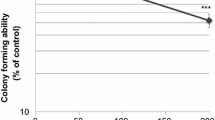Abstract
Thiourea was investigated for its capacity to cause DNA alterations in cultured mammalian cells. The induction of DNA repair in primary rat hepatocyte cultures and of gene mutations in V79 Chinese hamster cells were used as biological endpoints. In hepatocytes, thiourea elicited a linear increase in DNA repair replication in the concentration range tested (5–25 mM). In V79 cells, thiourea (10–40 mM) significantly increased the frequency of 8-azaguanine-resistant mutants. The present results show that thiourea is weakly, but definitely, genotoxic and mutagenic in cultured mammalian cells.
Similar content being viewed by others
References
Althaus FR, Lawrence SD, Sattler GL, Longfellow DG, Pilot HC (1982) Chemical quantification of unscheduled DNA synthesis in cultured hepatocytes as an assay for the rapid screening of potential chemical carcinogens. Cancer Res 42: 3010–3015
Bielschowsky F (1949) The role of thyroxine deficiency in the formation of experimental tumours of the thyroid. Br J Cancer 3: 547–549
Bradley MO, Patterson S, Zwelling LA (1982) Thiourea prevents cytotoxicity and mutagenicity, but not sister-chromatid exchanges in V79 cells treated with cis-diaminedichloroplatinum (II). Mutat Res 96: 67–74
Fitzhugh OG, Nelson AA (1948) Liver tumors in rats fed thiourea or thioacetamide. Science 108: 626–628
Göggelmann W (1981) In vitro Mutagenität: Salmonella/Mikrosomen-Test (Ames). In: GSF München im Auftrag des Umweltbundesamtes Berlin (Überprüfung der Durchführbarkeit von Prüfungsvorschriften und der Aussagekraft der Grundprüfung des E. Chem. Ge., pp204–210)
Langenbach R, Freed HJ, Huberman E (1978) Liver cell-mediated mutagenesis of mammalian cells by liver carcinogens. Proc Natl Acad Sci USA 75: 2864–2867
Lonati-Galligani M, Lohman PHM, Berends F (1983) The validity of the autoradiographic method for detecting DNA repair synthesis in rat hepatocytes in primary culture. Mutat Res 113: 145–160
McCann J, Choi E, Yamasaki E, Ames BN (1975) Detection of carcinogens as mutagens in the Salmonella/microsome test: Assay of 300 chemicals. Proc Natl Acad Sci USA 72: 5135–5139
Purves HD, Griesbach WE (1946) Studies on experimental goitre. VII: Thyroid carcinomata in rats treated with thiourea. Br J Exp Pathol 27: 294–297
Purves HD, Griesbach WE (1947) Studies on experimental goitre. VIII: Thyroid tumours in rats treated with thiourea. Br J Exp Pathol 28: 46–53
Rosenkranz HS, Poirier LA (1979) Evaluation of the mutagenicity and DNA modifying activity of carcinogens and non-carcinogens in microbial systems. J Natl Cancer Inst 62: 873–892
Rosin A, Rachmilewitz M (1954) The development of malignant tumors of the face in rats after prolonged treatment with thiourea. Cancer Res 14: 494–496
Rosin A, Ungar H (1957) Malignant tumors in the eyelids and the auricular region of thiourea-treated rats. Cancer Res 17: 302–305
Rossberger S, Andrae U (1985) DNA repair synthesis induced by N-hydroxyurea, acetohydroxamic acid, and N-hydroxyurethane in primary rat hepatocyte cultures: comparative evaluation using the autoradiographic and the bromodeoxyuridine density-shift method. Mutat Res 145: 201–207
Simmon VF (1979a) In vitro mutagenicity assays of chemical carcinogens and related compounds with Salmonella thyphimurium. J Natl Cancer Inst 62: 893–899
Simmon VF (1979b) In vitro assays for recombinogenic activity of chemical carcinogens and related compounds with Saccharomyces cerevisiae D3. J Natl Cancer Inst 62: 901–909
Simmon VF, Rosenkranz HS, Zeiger E, Poirier LA (1979) Mutagenic activity of chemical carcinogens and related compounds in the intraperitoneal host-mediated assay. J Natl Cancer Inst 62: 911–918
Sina JF, Bean CL, Dysart GR, Taylor VI, Bradley MO (1983) Evaluation of the alkaline elution/rat hepatocyte assay as a predictor of carcinogenic/mutagenic potential. Mutat Res 113: 357–391
Ungar H, Rosin A (1960) The histogenesis of thiourea-induced carcinoma of the auditory duct sebaceous (Zymbal's) glands in rats. Arch De Vecchi Anat Path 31: 419–430
Wiebel FJ, Brown S, Waters HL, Selkirk JK (1977) Activation of xenobiotics by monooxygenases: cultures of mammalian cells as analytical tool. Arch Toxicol 39: 133–148
Williams GM (1976) Carcinogen-induced DNA repair in primary rat liver cell cultures: a possible screen for chemical carcinogens. Cancer Lett 1: 231–236
Yamaguchi T (1980) Mutagenicity of isothiocyanates, isocyanates and thiourea on Salmonella typhimurium. Argic Biol Chem 44: 3017–3018
Author information
Authors and Affiliations
Rights and permissions
About this article
Cite this article
Ziegler-Skylakakis, K., Rossberger, S. & Andrae, U. Thiourea induces DNA repair synthesis in primary rat hepatocyte cultures and gene mutations in V79 Chinese hamster cells. Arch Toxicol 58, 5–9 (1985). https://doi.org/10.1007/BF00292608
Received:
Accepted:
Issue Date:
DOI: https://doi.org/10.1007/BF00292608




